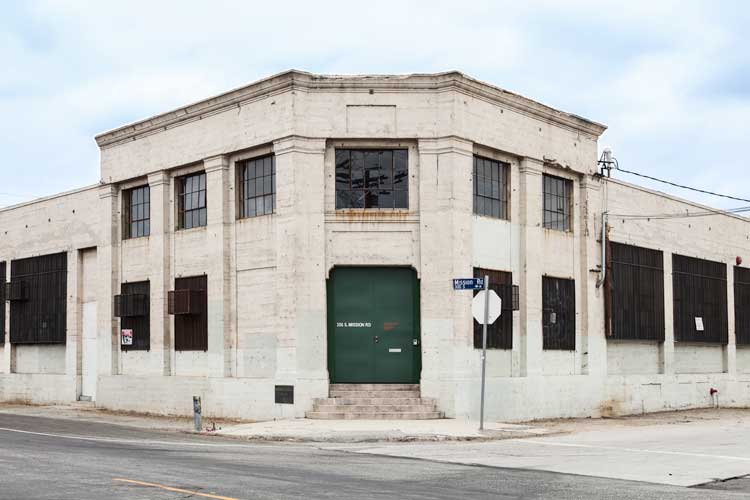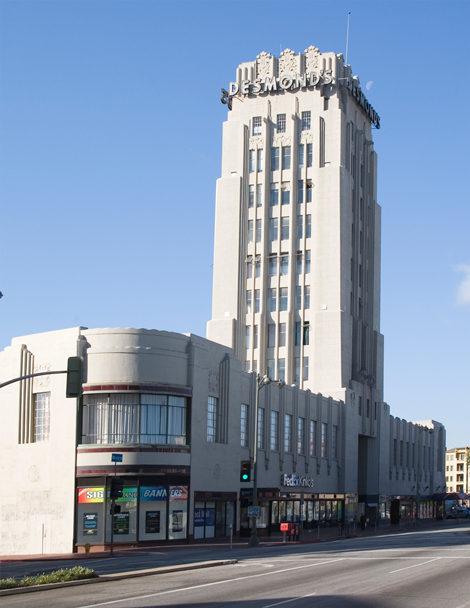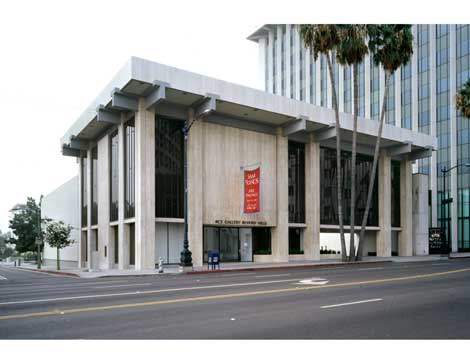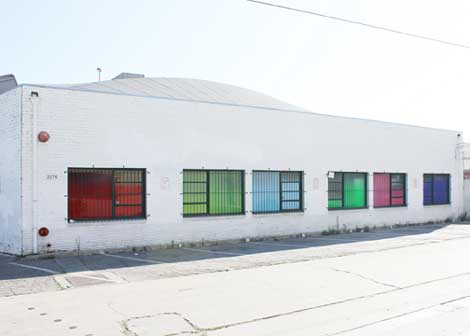La Cienega Boulevard, as it traverses Beverly Hills, West Hollywood and Los Angeles, appears not to have changed much over the last few decades, until you hit Venice Boulevard. Trailing south into Culver City, the character of the boulevard shifts dramatically. What was once a gasoline alley of automobile repair and supply shops is now a vibrant gallery district. At Washington Boulevard, looking east or west, a creative corridor seems to have taken hold, with architecture and design studios sharing the boulevard with art galleries like Mark Moore, Susanne Vielmetter Los Angeles Projects, Roberts & Tilton and Koplin Del Rio, among others.
If however, instead of continuing down La Cienega, you turn west at Venice Boulevard, the perspective exposes a far more random and ravaged aspect of West Los Angeles almost clear to the coastline. Like many major thoroughfares in Los Angeles, Venice Boulevard is a cautionary tale in late industrial development, poor urban planning, and rampant speculation. Along the scarified streetscape, some of the surviving architectural fragments have been restored or repurposed. The Ivy Substation (a Mission Revival remnant of the Pacific Electric light rail system) is now the Actors Gang Theatre. Unless they took the 10 freeway, Doug Chrismas and Peter Goulds would likely have passed it en route to Venice, and what would become their iconic galleries; and decades later, it is likely that Gavin Brown did, too.
Five miles down Venice from Culver City, Brown might have been reminded of the Ivy Substation by a similarly designed 1930s substation a short walk from fashionable Abbott Kinney Boulevard. Brown did not respond to questions for this article, but it may be reasonable to assume he considered the space as a potential gallery location. Instead he brought it to the attention of Dominique Lévy and Robert Mnuchin of L&M Arts in New York. “We loved the land, and loved the idea of building something new next to something ancient,” said Lévy. “An indoor-outdoor space that would take full advantage of the Venice light.”
Lévy spoke only a month after she and Mnuchin had announced their intention to close the gallery; but, in speaking with Los Angeles director, Sarah Watson, and later to Mnuchin himself, the love clearly lingered on.
The plan Mnuchin and Lévy painstakingly developed (with Kulapat Yantrasast of wHY Architecture) for the property envisioned the gallery as a destination space—an art park, meticulously landscaped and laid out for generous sculpture and installation space amid the pristinely placed and lighted galleries that reinforced its landmark pedigree.
On an early afternoon this past summer, the galleries fairly glowed in perfectly modulated natural light that made the physical walk-through itself a moment of illumination. The show–an insightfully curated (by Harmony Murphy) group of contemporary artists influenced by the Arte povera movement of late 1960s-early 1970s Italy–would not have been out of place at a museum. After the recent succession of curated/historic and contemporary solo shows, including Louise Nevelson, Monica Majoli and Jenny Holzer, the loss seemed inconceivable.
“There were far fewer [New York] galleries there when we opened,” said Lévy. “We had hoped to work with artists that didn’t have representation in LA That becomes very difficult when another gallery with an interest comes in.”
Lévy spoke in very general terms. The only competing New York gallery she mentioned by name was Matthew Marks, and only by way of recapping the recent chronology of New York galleries opening LA branches. Both Lévy and Watson characterized the decision to close L&M’s Venice gallery, as the not-altogether-surprising outflow of the parent New York gallery’s dissolution.
But it was hard to avoid the impression that she was referring to Hauser & Wirth, an international powerhouse in the art world, who in late May announced their partnering with Paul Schimmel, MOCA’s former chief curator, to open a gallery in Los Angeles. Almost exactly two weeks later, Lévy and Mnuchin announced their intention to close the Venice gallery.
Lévy’s comment highlighted another problem of doing business in the globalized art world. Galleries now compete for talent globally. The zig-zag career trajectory of artists has accelerated in recent years, with artist rosters frequently overlapping between LA and New York, as well as a sprinkling of international galleries. The largest international galleries disturb this ecosystem.
Both Lévy and Mnuchin vigorously denied the Hauser & Wirth announcement had anything to do with their decision. But Lévy alluded to more fundamental factors. “It became too much for a collector scene that small. The location was a bit eccentric–it was a destination–and the local collectors were a bit lazy about going that far.”
“You can’t sell art to fish.” Doug Chrismas, Ace Gallery’s long-time principal and prominent, if elusive, figure in the Los Angeles art world since the 1970s, summed it up bluntly. “For a while I ran two spaces – one on Melrose, and one in Venice. I opened the space on Melrose in order to talk with collectors and communicate with the public. You’re in the realm of reaching out to people to educate them about your artists so they’ll see their exhibitions; and it was difficult to get them to come out to Venice.”
Chrismas knows something about destination spaces–in Venice and elsewhere in LA Long before LA Louver opened its Frederick Fisher-designed gallery, openings at Flow Ace, later simply Ace, his original gallery on Windward Avenue, attracted throngs that seemed to all but shift the coastline. Although Ace in no way eclipsed the most prominent galleries still clustered around La Cienega and West Hollywood in the late 1970s, its energy and impact during those years was inescapable.
Ace’s openings may no longer create the buzz they once did, but in strictly physical terms, from its cavernous galleries on the second floor of the landmark Desmond’s Tower on Wilshire Boulevard, the gallery’s place is as central in the LA art world as ever.
“I was down there because my artists were down there. When the artists started to move from the beach, there was no rationale for keeping my business at the beach. Why L&M did what they did is difficult to understand. Venice is a wonderful beach community, but it had already been written off.”
It’s not as if Ace’s artists necessarily chose to cluster around the Miracle Mile or Hancock Park–although collectors probably don’t complain about Ace’s two Wilshire Boulevard locations. Now as ever, artists are looking first for space–large or small, live-work, or strictly studio, not too far from their living situations and ideally with some proximity to other artists and at least some urban amenities–which in this century means that they are looking east, ranging northward to LA’s northeastern suburban reaches or south in quasi-industrial neighborhoods, some of which were once, or continue to be given over to apparel manufacturing and warehousing.
Whether Gavin Brown ever shifted his gaze eastward away from the Venice light is anyone’s guess. It was artist Laura Owens (who shows with Gavin Brown’s Enterprise in New York) who found the space at 356 S. Mission Road at the edge of Boyle Heights, an L-shaped warehouse space of almost 12,000 square feet, beautifully lit by enormous, regularly spaced windows, and persuaded him to lease it–originally for a period of one to two years, which was later extended to four years.
In the context of her own work, Owens saw the collaboration as part of a larger “10-year project.” Before finding the space, she had focused on spaces with “specific architectural referents,” such as an old church and vacant theatre at the eastern end of Melrose Avenue. Owens was firm about identifying the space as “not a gallery, but a project space”–intended to be a collaboration, not merely with Brown, but with other artists, curators and creative elements in the community. Early on she brought in Wendy Yao, the muse and proprietor of Ooga Booga, on Broadway in Chinatown, to open a second, more expansive store. Yao not only put the space to good use, but began bringing in other artists and performers and organizing performances, music, film screenings and other events.
Although Yao and Owens closed the Mission Road Ooga Booga store for the summer, along with Owens’ inaugural show of her 12-foot tall paintings, it will be back in September, alongside a sculpture show set to open as this issue goes to press. Although Owens sees exhibitions as only a part, and perhaps not even the most important part of the project’s mission, she envisions at least two major shows a year, along with a couple of group shows. (A Sturtevant retrospective was being planned for the end of September.)
The resurgent gallery and exhibition activity downtown and east of Alameda may be less a reflection of the most recent infusion of New York commercial energy, than a reminder that LA both invents its own rules and breaks them unhesitantly. Before Owens’ downtown detour, before L&M-Venice was so much as a glimmer in Robert Mnuchin’s eye, Mara McCarthy’s Box (in the neighborhood once occupied by LACE and Al’s Bar), fueled by father Paul’s and her own curatorial demons, had dedicated itself to stirring art world ashes to raise old phoenixes. The McCarthys may have stirred up more than even they had anticipated. Between November, 2011 and July, 2012, Hauser & Wirth chose to exhibit Wally Hedrick’s “The Box,” in addition to a number of other Box artists curated by McCarthy, at both their Zurich and London/Piccadilly galleries.
In the meantime, Davida Nemeroff and Mieke Marple, who had staked out a place, almost a state of mind, of their own still further afield of the usual art world turf, on Avenue 19 in Lincoln Heights, were looking to expand Night Gallery into a space that might come to life in daylight hours with room to embrace a growing audience that frequently overflowed into its mini-mall parking lot.
What they found might swallow that mini-mall whole–a hangar-like space of 6,200 square feet on a property approaching 20,000, closer to downtown, but set off east of Alameda in the apparel-manufacturing area. Its amorphous definition might be expected to appeal to the perspective/perception-tweaking imagination of artist Yunhee Min, who had seen the space with Nemeroff and Marple. Min, in turn, suggested they consult with her friend, architect Peter Zellner.
“I went to look at the site with them before they took the lease. [It was a discussion] very specific to Night, geared to its very different mission–[that it would be] a hybrid … space to produce something very informal because they program events, performances; something [that could function as] a social gathering space for artists.”
Zellner described the design experience as more “collaborative… without a fixed target.” It was a departure in other ways, too. Zellner’s firm, Zellnerplus, has had a significant impact on the look of art exhibition spaces throughout Los Angeles; and particularly Culver City. The look (and certainly the light) of galleries like Mark Moore and Susanne Vielmetter Los Angeles Projects–flowing, soaring, skylit spaces, with exposed rafters, enclosed by expansive light-industrial spaces–is the work of Zellner and his teams of designers and engineers. Zellner was also the architect for LAXArt and the short-lived LA outpost of Christian Haye’s adventurous Harlem gallery, The Project (which was originally located downtown). (The space is now occupied by International Art Objects.)
Night Gallery and The Project stand in distinct contrast to Zellner’s immediately preceding project in almost every respect: Matthew Marks’ Los Angeles gallery is an elegant 3,000 square foot minimalist temple to art. (The Zellner ‘temple’ has since been augmented by an additional 5,000 square feet carved out of storefront space just around the corner on Santa Monica Boulevard.) Its location–just off Santa Monica Boulevard, a mile or so from La Cienega and more or less squarely between Regen Projects and Margo Leavin’s now shuttered gallery in West Hollywood–is also much closer to the LA art world’s original epicenter.
Zellner’s design process was deliberative and rigorous, with the structure built from the ground up, revised and re-revised, engineered and re-engineered to accommodate Ellsworth Kelly’s 40-foot long, 5,000 pound black aluminum panel, mounted about five inches off the top of the façade. The deep, capacious skylights that softly and evenly light the galleries, even on cloudy days, essentially required an additional storey of structural support. It is the sort of serene space where the muses will be seen and heard regardless of the art on view.
Where Night is still evolving (albeit in quantum leaps of sophistication), ‘feeling’ and ‘meaning’ have yielded some synthesis at Matthew Marks–as have artists with collectors. This is a gallery with a long track record with both Los Angeles artists and collectors. Still, it was difficult to get Marks or his Los Angeles director, Adrian Rosenfeld, to discuss where they saw the gallery positioning itself. Marks himself would not comment for this piece. Rosenfeld dismissed the notion that the relatively cheap real estate was a motivation. With respect to MM’s specifically LA evolution, Rosenfeld says, “We aren’t making any rules for ourselves; it has to feel right.” Acknowledging Marks’ established strength in its West Coast artists, generally (e.g., Charles Ray, Paul Sietsema, Vincent Fecteau, etc.), Rosenfeld pointed to the New York side of the artist development equation. “Many of our artists have not shown here for a long time and some, like Katharina Fritsch and Brice Marden, have never had one-person shows in Los Angeles at all. I think that our program stands to contribute quite a lot to the scene.”
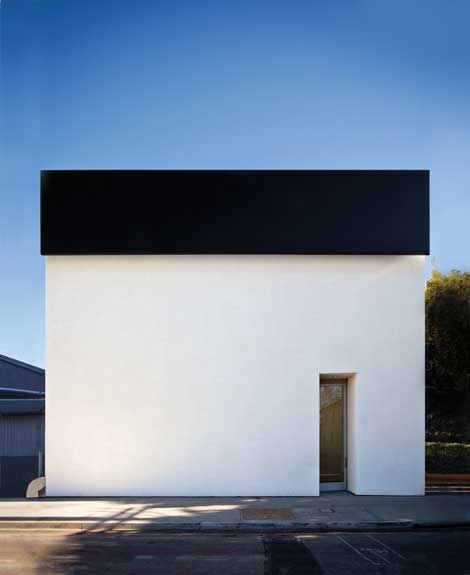
Exterior view of Matthew Marks Gallery, Los Angeles, sculpture by Ellsworth Kelly, photo by Joshua White, courtesy Matthew Marks Gallery.
In that sense, Matthew Marks’ ‘strategy’ may not be so different from Night’s. “Among an artist’s primary audience are other artists,” says Rosenfeld. In a marketplace that has effectively abandoned specialization for a more speculative curatorial approach, what galleries seem to be looking for is a synergy between the exhibiting artists and their peers, students or aspirants. “LA is a great city in which to open a gallery because there are already so many museum collections and art schools attracting huge numbers of artists to the city.”
The Perry Rubenstein Gallery represents a slightly different kind of synergy–call it fashion and art, wanderlust and glamourlust. Beyond that is the built-in synergy of Rubenstein’s marriage with PR/marketing maven, Sara Fitzmaurice, whose company, Fitz & Co. specializes in press/public relations and events for art and cultural institutions. Rubenstein appears to have embraced the Hollywood ethos in its totality, vigorously promoting the gallery’s brand in everything from signage and billboards to the celebrity-studded events that inaugurated the gallery late last spring. In closing his Chelsea galleries permanently and transferring his entire operation here, he has also cleaned the slate in a way his peers, here or in New York, would have never dared. (Rubenstein’s impressive, wHY-designed gallery is the subject of another feature in this issue.)
Whether or not Rubenstein has become a “destination” gallery (as he has claimed), what has clearly emerged from the ‘evolution’ to date is that North Highland Avenue has become a magnetic new art corridor in Los Angeles. With Regen Projects’ spacious quarters (redesigned by Michael Maltzan) a lodestone firmly anchored on Santa Monica Boulevard just one block east (and Redling Fine Arts just across the street), Michael Kohn poised to open a 10,000 square foot gallery right next door to Rubenstein sometime this Fall, Diane Rosenstein only a few blocks away, and ironically, even LAND’s office perched in a mini-mall at the northeast corner of Highland and Santa Monica, it’s as if the LA art world’s center of gravity has within a single decade’s time shifted once again. Hannah Hoffman’s pristine 7,500 square foot gallery (also originally a film supply warehouse) had scarcely been open a month when this article was still in notes.
Now the Maurice and Paul Marciano Art Foundation have announced their intention to turn the landmark Scottish Rite Masonic Temple, a 4-storey, 90,000 square foot space on Wilshire about a mile east of Highland, into a private museum— with the redesign by wHY Architecture’s Kulapat Yantrasast.
Chrismas sees LACMA itself exerting its own centripetal force; and certainly there is no other ‘encyclopedic’ museum (as Paul Schimmel also pointed out) with a comparable emphasis on the contemporary. “When I was up on Melrose, it became clear that the intelligent thing to do was to get as close as I could to LACMA.” La Brea, he believes, may add some galleries to its own constantly changing corridor. “It’s only natural that this area will be the future home to a lot of mainline galleries for a number of years.”
There is in fact increasing density and consolidation throughout the city. But the forces effectuating this transformation seem both global and intrinsically cultural. Even in a region where location defines identity (and certainly status), the shape-shifting currency of culture contends with the currency of space. Notions of proximity are continuously reconfigured and renegotiated both through the technology of global communications and the interventions and interactions of artists themselves.
More than any particular gallery or even cultural institution, as Paul Schimmel pointed out, it is Los Angeles itself that is the destination. More specifically, it is the amorphously defined community of LA artists that is the focus of the international collector. As the geographical axis has perceptibly shifted east, the points of convergence among artists and galleries, artists and collectors, and particularly among artists themselves remain in constant motion. It is this locus–simultaneously abstract and concrete–that is the common terrain of galleries as seemingly disparate in their missions and audiences as Night Gallery and Hauser & Wirth.
It was inevitable early on that the path of Paul Schimmel, a curatorial force in Los Angeles from the early 1980s, would converge with that of Hauser & Wirth. “Hauser & Wirth and I go back to its very formative years. Hauser & Wirth started as a Zurich gallery…, but from the very beginning was really engaged in supporting and developing the culture of LA artists.” Less inevitable was that they would cross again–facilitated ironically by Eli Broad’s heavy hand, inevitably unleashing still further synergies.
Schimmel is celebrated for his relationships with many artists. Less celebrated are his relationships with collectors, which are of a piece with his relationships with the community as a whole. “One of the great things about local collectors is that, although they’re not at all provincial, in some ways they remain regionally tied. You don’t want your collectors to lose their close connection with the community.” Although Schimmel will undoubtedly strengthen this connection, he acknowledges that the Los Angeles gallery will also be a “very strong venue for international collectors who [formerly] engaged in New York, London and Zurich.” It’s a modest way of saying that Hauser, Wirth & Schimmel will be a ‘destination’ on its own terms.
At the same time, it has to be assumed that the ultimate synergy of an artists’ curator partnering in what has a reputation for being an artists’ gallery will yield something rich in invention and originality. “My first audience is always the audience of artists. If you can affect, influence and educate artists, you’ve done something of real lasting value. Hauser & Wirth are very close to that creative spirit.” It is also likely, over the long term, to be lucrative.
The re-mapping of LA’s art world commerce is far from being merely a function of capital infusions or property transactions emanating from New York. This is not the first time New York or international dealers have staked out LA turf. The geographic redistributions index a much larger cultural, technological and economic transformation that impacts the art being made on every level. Artists are feeling the pressures and responding to them in their work. “We’re making art about our lives,” says Olga Koumoundouros. Koumoundouros, who works from a studio in the Highland Park area, has closely observed the issues surrounding living and working as an artist, as well as the dislocations and discontinuities of LA’s shifting urban landscape more generally. “How do I corral this living–show my existence in a corporeal sense? I live here…. I’m going to mark my boundaries.”
When Mnuchin was asked what he would miss most about closing L&M Arts in Venice, he described a “tremendous feeling of pride,” seeing the diversity of people flocking to the gallery openings–not simply the floating circus of LA’s art world, but “the people in Venice and surrounding areas who embraced it. It became their place. That was exciting.”
The notion of community is only loosely grasped here (Hollywood, for several decades, being the notable exception). In its stead has always been the lure of destination, ever more elusive as development rampages through an increasingly gridlocked city. Night Gallery (soon to be joined in its quadrant between 16th and Washington by François Ghebaly’s and Cesar Garcia’s galleries), within the larger domain of its social-cultural nexus, and Hauser, Wirth & Schimmel, its deep regional involvement welded to a global embassy to collectors–each in its distinct way seem to be intent on building a community from the LA art world diaspora. “We are a small gallery with a humongous gallery space. Anyone can come here,” says Nemeroff. It is the invitation LA has always extended to the world.

